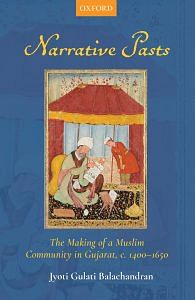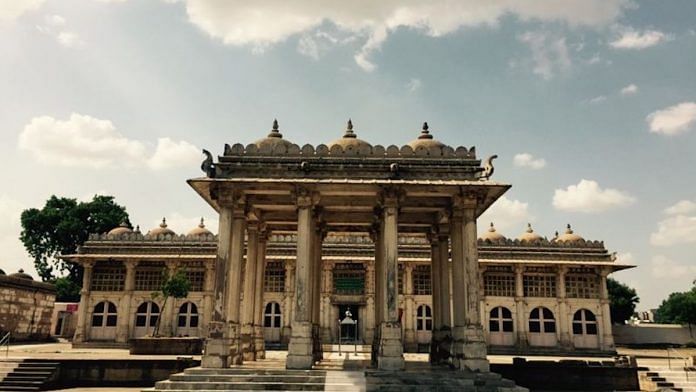The historic core of Ahmedabad stands as a testament to the immense power, wealth, and patronage commanded by the Sultans of Gujarat, the city’s fifteenth-century rulers. The historical remnants of the city’s fortifications, gates, and palatial structures are a reminder of Ahmedabad’s early fifteenth-century foundations and its rise as one of the largest urban centres in South Asia. The graves of the most powerful of the Gujarat Sultans, however, were not located in the capital but accommodated within the tomb complex of a Sufi preceptor Shaykh Aḥmad Khattū (d. 1445) in the southern suburbs of the city. Placed together in one room, the royal tombs do not make a statement of temporal authority and leadership. Instead, they speak of humility. They acknowledge the presence of a greater force in the political realm of the Gujarat Sultans. That greater force emanated from the unlikely figure of a Sufi migrant to Gujarat from north India with no claims to any illustrious lineage. Looking at the structures of the Sarkhej complex, spread around a seventeen-acre lake, it is impossible to not conclude that the Sufi must have been a very important and special figure.
When Le Corbusier, the eminent French architect most popularly remembered in India for designing the city of Chandigarh, visited Sarkhej in the 1950s, he remarked to his fellow architect B.V. Doshi, ‘Why do you need to visit the Acropolis in Athens when you have this here?’ The label ‘Acropolis of Ahmedabad’ caught on in the press as it captured the monumentality of the structures that marked the expansive Sarkhej complex. However, the memory of Aḥmad Khattū, the Sufi who had inspired such architectural sophistication and collection of multi-use structures, had increasingly eroded in the public realm. Sarkhej had lost its connectivity and accessibility to the erstwhile capital of the Gujarat Sultans, which ironically continued to develop as a commercial metropolis of Gujarat. The Sufi once imagined as the spiritual protector of the Gujarat realm had become a largely forgotten figure whose shrine-complex now dominated the small village of Makarba.
However, Shaykh Aḥmad Khattū’s fortunes changed once again. At the turn of the twenty-first century, the memory of the Sufi began to be revived as multiple non-profit and government initiatives sought to restore the architectural glory of the Sarkhej complex, now seen as a symbol of India’s ‘syncretic culture’, a prime example of Indo- Islamic architecture. Over the first decade of the twenty-first century, Sarkhej was developed as a cultural resource centre where French artists performed violin and cello concerts, poets congregated to participate in a mushā‘ira (poetic gatherings), and Sufi festivals and fusion concerts were organized to bring attention to the historic site.
The celebration of Janamashtami (the birth of Lord Krishna) in the complex by nearby villages, believed to have been a five-hundred-years-old tradition that was discontinued after the communal riots of 1985, was similarly revived. The Sarkhej complex is now fairly well-integrated into the circuit of sites that tourists to Ahmedabad visit. It is easily accessible through the Sarkhej–Gandhinagar highway, and in travel brochures it is touted as a place to experience calm and serenity, a get-away destination from the crowd and chaos of the city. It even served as a setting for the shooting of a Bollywood movie starring a popular actor. At the time of the writing of this conclusion, preparations for a sound, light, and multimedia show were underway at Sarkhej to display Ahmedabad’s rich historical and cultural heritage.
Also read: How colonial historians divided time to create false ‘Muslim kings vs Hindu kings’ story
The renewed interest in the architectural space of Sarkhej also reignited an interest in the life and teachings of Aḥmad Khattū and in the many manuscripts that lay unattended at the shrine for years. The establishment of the Roza library and a publication department have been particularly critical in ensuring the availability of historical textual material on the Sufi and his historical times in English, Urdu, and Gujarati at the shrine complex. The editions and translations of texts written by the Sufi’s disciples, Tuḥfat al-Majālis and Mirqāt al-wuṣūl ila Allah wa al-Rasūl, are once again in circulation and have been used to prepare detailed placards at the shrine to reconstruct the historical milieu in which Aḥmad Khattū created his lasting legacy.
Indeed, the production of texts such as the Tuḥfat and Mirqāt was, as I have argued in this book, absolutely critical in creating a reserve of historical memory that was harnessed by later generations to reinterpret the important role of Sufi preceptors in both shaping the ‘region’ of Gujarat and anchoring the Muslim community in Gujarat. Aḥmad Khattū and his two fifteenth-century Suhrawardi Sufis, Burhān al-Dīn ‘Abdullāh (d. 1452) and Sirāj al-Dīn Muḥammad (d. 1475), all of whom had settled in Gujarat in the early years of the fifteenth century, were inextricably linked to a new state formation under the Gujarat Sultans in the narrative expressions of the period. Along with Persian courtly histories commissioned by the Gujarat Sultans, the narratives on the three Sufis compiled by their disciples and descendants from the fifteenth century represented the beginnings of sustained narrative articulations of a Muslim community’s past, and marked a decisive shift from the fragmentary record of Muslim presence in Gujarat in the preceding period. In other words, from largely dispersed inscriptional instances of Muslim settlers in coastal and interior parts of Gujarat, the texts in the fifteenth century expressed an evolving sense of a regional community with its centre in Ahmedabad, the capital of the Gujarat Sultans. In these textual expressions, the history of the community had been anchored both by the Gujarat Sultans, who extended their political influence to the far reaches of Gujarat, as well as Sufis, who were believed to have sanctified the territory of the Sultans.
In the historical and narrative constitution of Gujarat’s unique and regional identity, the Sultans and the Sufis were no longer beholden to Delhi as a political and sacred centre. The greater confidence in the ability of the Sultans to sustain their rule triggered the desire to chronicle their victories in the well-established genre of the tawārīkh and claim a place among other contemporary Muslim rulers. The court histories of the Gujarat Sultanate were no longer written from the perspective of Delhi but from the sites where the Gujarat Sultans had established new centres of authority. At the same time, as members of the expanding learned community in Gujarat sought out by the Gujarat Sultans, Aḥmad Khattū and his Suhrawardi contemporaries played an increasingly central role not only as guiding figures but as important nodes around which other learned men coalesced and formed multi-generational relationships.
And these Sufis, their disciples, and descendants wrote texts too, texts that recorded the narratives of the Sufis’ lives and teachings, expressed a collaborative relationship to the regional Sultans and asserted the importance of regional sacred centres marked by the tomb-shrines of Aḥmad Khattū, Burhān al-Dīn ‘Abdullāh, and Sirāj al-Dīn Muḥammad in Sarkhej, Vatwa, and Rasulabad respectively. And while the Sultans integrated the physical territory of Gujarat through military campaigns, and administrative and institutional organization, the Sufis and their networks of family, education, and spiritual practice tied together multiple generations of learned Muslims to one another, and to the region. These material foundations shaped both courtly and non-courtly textual imaginations in which the success of the Muslim community was a result of the conjoined processes of state formation and the expansion of Sufi fraternities.
Also read: The Delhi prof who said tombs & mosques were not just ‘Muslim’, but ‘Indian Muslim’
Along with the tawārīkh or court histories focused on the accomplishments of Sultans such as Aḥmad Shāh and Maḥmūd Begarha, the textual recounting of three fifteenth-century Sufis—Aḥmad Khattū, Burhān al-Dīn ‘Abdullāh, and Sirāj al-Dīn Muḥammad—in a diverse set of Sufi texts was also instrumental in the early modern conceptualization of the history of the state, the region, and finally the Mughal province. The Mughal historiographical traditions did not seamlessly follow the Delhi Sultanate narrative traditions. Mughal imperial histories had reshaped the Sultan-centric histories of the Delhi Sultanate to produce a connected and integrated history of the Mughal realm.
The ability of the Mughal scholars to conceive of a pan-Indian imperial framework, however, rested on the existence of distinctive geographical units that were now conceived as Mughal provinces. The narratives that produced the historical knowledge on Gujarat within the first hundred years were thus critical in informing and shaping both imperial histories as well as biographical compendia of pan-Indian saintly lives written by Mughal elites. In the end, the narrativization of the Muslim community’s past in the fifteenth and sixteenth centuries was the triumph of the ‘historical’ moment. The consolidation of narrative pasts had successfully created a multi-generational record of Muslim settlement in Gujarat, which could now connect the history of the Muslim community under the Gujarat Sultans to the imperial Mughals.
Without the narrative power of texts, there would be little historical depth and meaning to the walls, structures, and spaces that mark the resting places of Aḥmad Khattū, Burhān al-Dīn ‘Abdullāh, and Sirāj al-Dīn Muḥammad in Sarkhej, Vatwa, and Rasulabad. Rulers had come and gone, and many individual Sufis and their lineages had prospered in Gujarat, but what triggered the historical imagination in the region was the legacy of the three foundational fifteenth-century Sufis, kept alive through shrines, descendants, and, most importantly, texts.
 This excerpt from ‘Narrative Pasts: The Making of a Muslim Community in Gujarat, c. 1400-1650’ by Jyoti Gulati Balachandran has been published with permission from Oxford University Press.
This excerpt from ‘Narrative Pasts: The Making of a Muslim Community in Gujarat, c. 1400-1650’ by Jyoti Gulati Balachandran has been published with permission from Oxford University Press.







They cannot tolerate even reading Muslim history…They forget that during Aurangzeb rule India was largest economy of World..
In the comments all are bloody bakhts… Mutr drinkers… gobar eaters… Illegal sons of Narendra Modi… ???… They cannot tolerate even reading Muslim history…They forget that during Aurangzeb rule India was largest economy of World..
Culture of invision is sprit of islam and so va called modern follower of jejus
?
Reads like a tribute to Bhaijaan Abbas Siddiqui from left front.
Lol,
All comments against writer
You guys have better knowledge than a historical expert?
Sufism in Gujarat is older than 10th century.
All of you should read books.
आधा ज्ञान बिना ज्ञान से खतरनाक है
Is there a way to report anti-India platforms and content like this one? Slowly they want to brainwash every last Indian that history starts with Afghan invasion and ends at British
As usual our historians think there was nothing in our historical places worth their interest before the Muslim invaders came to rule.
Why do all this,?
Just say that indian history starts around 15th ce
Before that india was in total solar eclipse
You are right sir
India was gifted by the so called Aryans came from Europe, then Greeks Alexander the great, then the Arabs, Persians, Turkishs, Mughals, The British all of then gave us written history except the prejudiced, biased Hindus, the Sanatanis. They gave us myths. Vedas, Upanishads, Puranas, Ramayana, Mahabharat, Arthashastra and all other literatures, construction they all gave us myths. Only the Muslims, Christians, Jews, Persis and all other religious groups are full of liberalism of course except the the prejudiced Hindus.
Shame in u print
Ahmedabad is originaly karnavati city. renamed as Ahmedabad. karnavati is devloped by karandevsinh solanki in before 12 century.
Us se pehle gujrat ki koi history nhi thi kya????
This is the dumbest article and e-media. Completely baised. I am going to do an online fir on this media for the fake propaganda and anti national ideology.
The print is worst baised media and should be banned.
Why u people are so leftist? Can’t u be neutral? We know ur propaganda Print. U mock us Hindus on behest of ur lords.